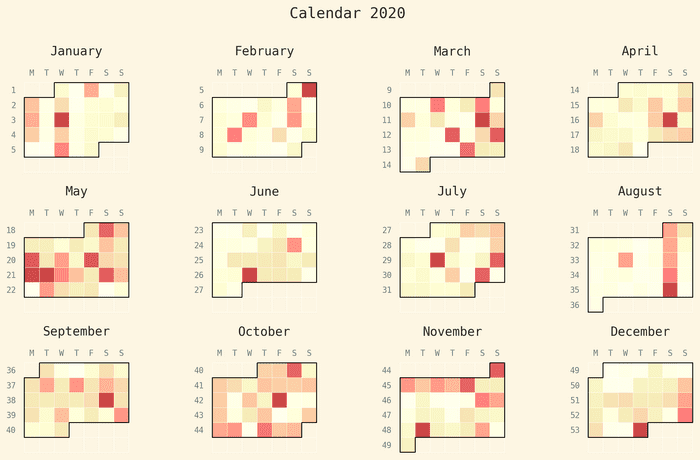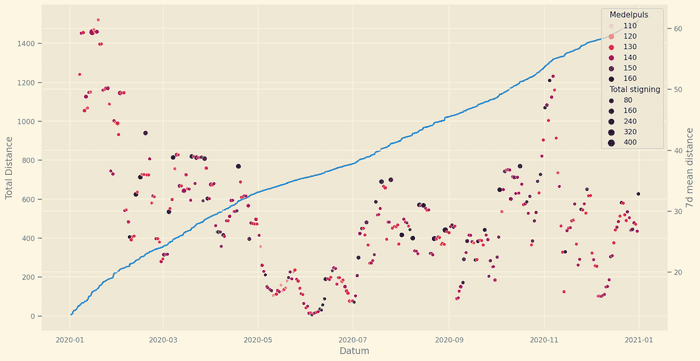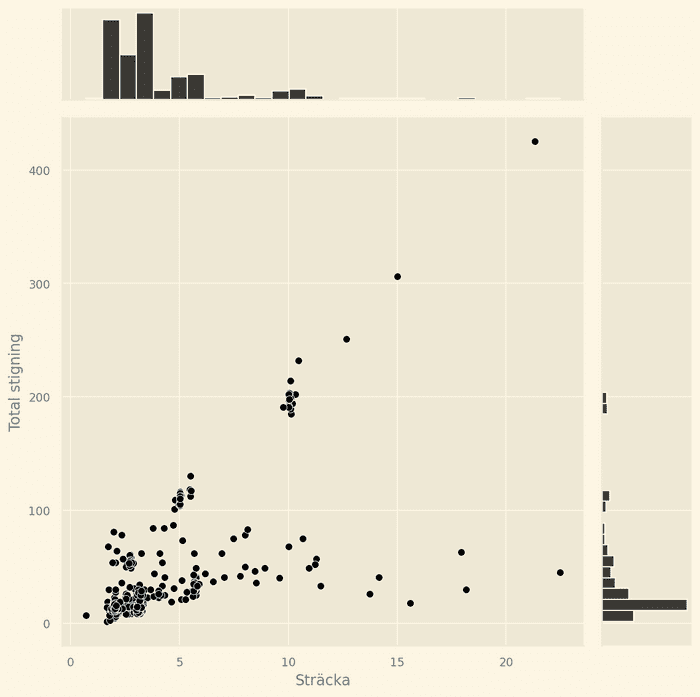365 Days of Running Every Day
People tend to either love running or hate it. Sure, there are a few inbetweeners. But those who manage to make a habit out of running tend to end up in the love camp, while those who fall off early struggle to get back and eventually end up hating it. Which secrets do you have to unlock in order to end up in the prior?
Background
As a young boy and though my teens I played a team sport called Floorball. It was the biggest indoor sport in Sweden at the time. Similarly to hockey, you have a club, but it’s made of plastic. Instead of a hockey puck, players chase a hollow plastic ball with holes in it. And instead of ice, you simply run around on the floor. As a player you run around a lot, but mostly in short bursts. You play for a couple of minutes until you get tired, then sit on the bench while one of your team mates take over. It’s not really an endurance sport.
After years of playing Floorball, I quit and instead took up strength training and trail running. I didn’t know how to improve as a runner. I found much greater appeal in lifting weights, because the results came very quickly. Perhaps mostly thanks to the natural hormone boost during my teens, but gains nonetheless! My mom, who raised me as a single parent, has always been a keen runner. She told me to vary my training and stick to running a few times a week in order to stay healthy. I managed to motivate myself running fairly consistently during the spring, summer and autumn. But never in the winters, or on days with shitty weather. It was mostly warm up sessions, before hitting the gym, so I never really improved my endurance or aerobic capacity.
So I can’t really say I’ve ever had a good running habit. There’s been periods of consistency, but never lasting more than a few months. Only in my older days, then about 30, did I realize my love for running, and that I would like to make a consistent habit out of it.
Challenge: Become a Consistent Runner
Two years ago I challenged myself to stay away from refined sugars for a whole year. It was at the time one of the hardest things I could imagine ever giving up. Only a couple of weeks into the challenge I realized that it wasn’t going to be as hard as expected. While it certainly wasn’t easy, I had expected it to be much worse. In the end of 2020, I therefore wanted to up the ante a bit and set an even harder goal for myself.
This year’s challenge would be to run every day for a whole year. No exceptions! My feelings were much stronger this time. A mixture of nervousness and excitement. Could it even be done, without getting injured? Would I be able to motivate myself to get outside each and every day, no matter location, weather or what I did the previous day?
This is what’s called a stretch goal, intentionally designed to be difficult to achieve.
Running Plan — Keep it simple.
The primary goal for this challenge was to build consistency — I wanted to form a new habit, no fuss. The focus was not on pace, distance or anything else. To make things simple, the rules were set as follows:
- Run every day, for a whole year.
- Running must take place outside, treadmills not accepted.
- Every run must be tracked and logged with a GPS device.
My Garmin watch has a feature called “Garmin Coach”, in which you can activate a program that is customized to meet your running goals. This intrigued me. I wasn’t able to input my exact criteria, but I decided to accept a 10k-program in order to get some training inspiration. Nothing else was used for planning or coaching, other than what I’ve already mentioned.
Fast Forward 365 Days of Running…
That’s it for 2020, what a year it’s been! It’s been stressful at times, and a very unique and strange year overall. But if anything, the COVID-19 Pandemic, has made me realize I have so much to be grateful for.
The virus initially made me worry about whether I would be able to complete this challenge. I knew running probably wouldn’t be a very good idea if I caught it. But as time progressed, and so many people got ill and even died, I stopped caring about the challenge. It didn’t stop me, but every day waking up healthy was simply another opportunity to be grateful that I would be able to run. It motivated me in ways I could have never imagined.
The year started out with way too much running volume for my fitness. As mentioned in the planning section, I used Garmin Coach to motivate me initially. I followed the program, and it was super fun to learn about different kinds of training runs. Unfortunately so much fun that I neglected listening to my body’s signals. Averaging 60 km per week turned out to be too much for me. My legs were pretty much done for already in April. Running volume was involuntary reduced to combat an injury in my right Soleus caused by overtraining.
Getting injured that early on made me feel like a failure. My body ached with each step on the pavement, and it simply wasn’t fun anymore. Instead of exploring new tracks around my area, like I had planned, I was stuck running the same short route daily for most of May and June. Only to get by, and get that mark in the calendar.
In an attempt to ease my pains, I got a pair of new shoes. Altra Tourin, which according to my research would be good for recovery. The same week, I also visited a physical therapist to get my Soleus checked up. The shoes combined with my reduced running volume and a couple of daily rehab exercises eventually helped heal my body. But my confidence was greatly damaged.
I’m bummed that I couldn’t run as much as I wanted during the summer. But when checking back at my initial plan, I realize that distance, pace or any other performance metric weren’t part of this challenge in the first place. The goal was only to get that check mark in the calendar, every day of the year. No more, no less.
So yeah, even though my injury made me feel like a failure, I can now look back and appreciate that I have succeeded with the challenge I set a year ago.
This combination plot includes all my runs during 2020. The solid blue line plots the cumulative distance over time. The dots in the background shows the 7 day mean distance, average heart rate and elevation in meters. My feet trotted a total of 1.521 km and 15.257 vertical meters climbing. The longest run lasted for 3 hours.
The dots in the plot illustrates a very high effort at the start of the year, followed by a dip in May lasting to July due to the injury. Most of the runs were quite short at around 3 km, lasting about 19 minutes.
Overall, I’m satisfied with the year. I completed the challenge. But not without injury, like I had envisioned. Nonetheless, I’ve won back my love for running. Now I want even more of it in my life. You can feel depressed and unmotivated before a run, but in my experience, you always feel at least slightly better after. Imagine if all the benefits of running could be bottled up and sold as a pill.
Double or Nothing?
Running every day has been a great experience for me. Having committed to this challenge, and sticking to it, has taught me so much about myself. It is hard to explain why, but I think simply being outdoors every day would probably be enough to experience it. And the feeling of accomplishing something every day, even if it’s trivial, is very rewarding.
Most of my challenges only last for a year. But I intend to continue with this one and run every day for another year. During this challenge, I realized there are other people doing the same thing. They even got a name for it: Runstreak. I don’t care for it, but will continue doing my own thing.
When plotting distance and elevation of my 2020 running year, one can see a lack of variation. It’s also obvious that most runs were on flat terrain. For next year, I plan to do more trail running in varied and elevated terrain. There is an added psychological benefit of being in nature instead of the city, and the varied terrain helps avoid injury by distributing the load over a wider range of muscles in the body.
My best running memories from this year come from Jämtland county, in Sweden. If only every run were as memorable as this one.
Next year’s challenge will also have a performance goal attached to it; I’m increasing my weekly mileage and aim for an average of 5 km per day.
I have learned that I need to change shoes more often, and listen to my body. Shoes loose their ability to cushion with use, which increases the strain on the body over time. My food intake will have to increase with the increased mileage, and so must my restorative sleep.
The keyword to bring with me into next year’s challenge is “variation”. Variation keeps things healthy and interesting. I plan to also do a bit more stretching. Other than that, just keep on running and enjoy!
Subscribe to the Newsletter
Get my best content by email. Emails are sent out no more than once a month. Your email address is safe and will not be shared with 3rd parties.






